Ijraset Journal For Research in Applied Science and Engineering Technology
- Home / Ijraset
- On This Page
- Abstract
- Introduction
- Conclusion
- References
- Copyright
Analyze the Properties of Hardened Concrete by Partial Replacement of Cement with Hypo Sludge and Steel Fibers
Authors: Jyoti Kaul, Rajwinder Singh Bansal , Arun Verma
DOI Link: https://doi.org/10.22214/ijraset.2021.39256
Certificate: View Certificate
Abstract
In the current circumstances, there is a significant need for long-term improvement in the cement industry, according to the findings. Moreover, Cement production consumes a lot of energy, therefore finding a waste product that may replace cement is a smart idea for the environment. As we know due to the modern lifestyle, advances in industry and technology have resulted in a significant increase in the amount and variety of waste produced in recent decades. Annually, the problem of debris accumulation arises all across the world. In order to reduce this, large scale paper production produces a large amount of sludge annually, which can be used to some degree in cement because of the similar properties of hypo-sludge to cement. The analysis has been subjected to the results are compressive strength of concrete after 7 and 28 days, split tensile strength of concrete after 28 days, flexural strength of concrete after 28 days and coefficient of permeability for cement after 28 days. Aim and objectives are to achieve target strength of M20 grade, replacing OPC cement by hypo-sludge and steel fibers. Percentage of Hypo-sludge are 10 and 20 percent by mass of cement and another mix with constant HS 10 % + fraction steel fibers 0.5 % and 1 %. Additionally, properties of steel fibers are using 30 mm length and aspect fraction 60. For this research lab experiment water cement ratio in hypo-sludge was .43-.45 and for steel fiber ratio was .5. Total 36 cubes were casted with 150mm length, 150 mm height and 150mm breadth, in the Observation for compressive strength and result evaluated after curing cubes at seven and twenty-eight days, total 36 cylinder of size 150mm and 300mm height had casted for evaluating the tensile strength and total eighteen beams had casted for flexural strength result calculated on 28th day of curing
Introduction
I. INTRODUCTION
As a result, the demolition of existing building and the construction of new ones has increased the demand for concrete. Large amounts of demolished concrete from demolition are either recycled or reused. Owing to the deprivation of landfill sites in urban areas, this waste is causing environmental problems. To minimize this problem in today's construction industry, sustainability is required and this can be accomplished by partially replacing cement with waste products such as glass powder, hypo-sludge, cement dust, tire, stones and blast furnace slag produced in industry. As we know, cement is an essential part of the construction industry and construction is made up of a mixture of cement, water, rough aggregates and fine aggregates. During the processing of one ton of cement, a significant amount of harmful gases is entering into the atmosphere, which is dangerous for our atmosphere so there is an immediate need to implement new approaches such as use of HS Hypo sludge is also known as waste from the paper industry. Paper production generates a significant amount of solid waste. Every year, this paper mill waste occupies a significant amount of local landfill space. It is critical to generate construction materials from these industrial wastes in order to address disposal and environmental issues. Sludge consisting of maximum calcium chloride and low calcium content, while silica content is limited. Paper mill sludge behaves like cement because of identical chemical properties, e.g. silica and magnesium. Hypo sludge may therefore be used to partially replace cement. As a result, Hypo sludge can be used to partially substitute cement in concrete. Whereas steel fibers Steel fibers improve the mechanical qualities of concrete by increasing its strength and tensile strength. For use in concrete, there are different types of fibers suitable. Hooked finished steel fibers are used mostly in the construction industry. In the 1970s, research related to steel fiber reinforced concrete was launched to increase its value, and since then, different types of steel fibers have been used. Imperative aspect ratio for demonstrating the fiber parameter. All cracking qualities, such as strength, energy absorption, stiffness, and impact resistance, are improved by SFRC processes. These are synthetic fibers used to improve the characteristics of concrete. In this laboratory research, hook-end steel fibers were used. The length of the steel fibers was measured using a scale, and the diameter of the steel fibers was evaluated using a Vernier Caliper.
II. RESEARCH AIMS & OBJECTIVES
A. Analyses and computing the compressive strength with destructive test performed on cubes at different percentages of H.S (10% and 20%) and constant percentage of H.S (10%) with different steel fibers fraction (0.5% and 1%). After evolution then compare the strength of the conventional concrete and HS+ FRC.
B. Splitting tensile strength was evaluated and laboratory tests were performed on cylinders with various proportion of H.S (10% and 20%) and constant percentage of H.S (10%) with varied steel fibers percentages.
C. In order to study the flexural strength of a beam with two percentages of hypo sludge and two percentage of steel fibers was tested.
D. To investigate water permeability, a cube is casted with varying percentages of H.S (10%) and 20%) and constant percentage of H.S (10%) with varied steel fibers percentages.
III. PROBLEM FORMULATION
To achieve the objectives, an experimental study was conducted to investigate the mechanical properties and water absorption of hypo-sludge-containing partial cement replacement of binders and steel fibers. The basic characteristics of the concrete demand analysis are examined, as well as the specifics of ordinary concrete, casting and curing procedures, and hardened concrete testing. A standardized fresh concrete sample was used in this investigation. Five concrete mix samples with various percentages of H.S and varied amounts of steel fiber fraction were employed in this study.
A. Methodology
Concrete cubes, cylinders, and beams are mixed in the following ways. In order to fulfil the study's goal, laboratory analysis was performed.
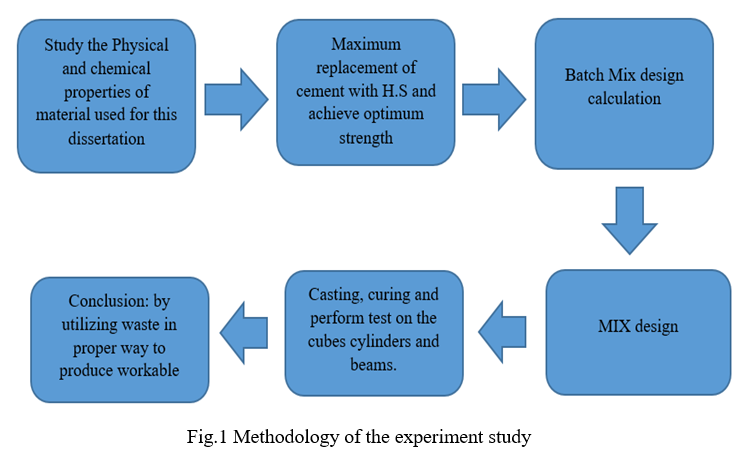
B. Material Properties (Physical and Chemical)
This method ensured that the material used in this dissertation performed well. Cement, fine aggregates, course aggregates, water, sand, hypo sludge, and fiber were utilized to make a concrete mixture.
- Cement, fine & course aggregate: Throughout the dissertation, ordinary Portland cement (OPC) grade 53 was used. Cement is a fine material made up of limestone, clay, and silica, among other things. When it comes into touch with moisture, it should be placed and stored in such a way that its qualities do not deteriorate Crushed stone sand was used in the concrete mix as fine aggregate. Before utilizing it in a concrete mix, it should be cleaned of foreign units. According to standard methods, the physical characteristics and fineness modulus of coarse aggregate were verified to be in compliance with IS 383. (1970). The coarse aggregate utilized in the experiment was locally available broken stone aggregates with a nominal size of 12 mm. On average, the aggregate size ranges from 10mm to 20mm.
- Water, Hypo sludge & steel fibres: Our institution laboratory provides the drinking water for curing of concrete mixes. Water should be pure and free of harmful chemicals including alkalis, oils, acids, salts, sugar, and organic materials, as well as other materials that could harm the concrete mix. Hooked end steel fibers were used in this lab experiment. Steel fiber length is measured on a scale, and steel fiber diameter is calculated using a Vernier calliper. The hypo sludge from Khanna Paper Mill Ltd. was used throughout the project. It was dried in the sun until all moisture was gone, then ground into a fine powdery dust.
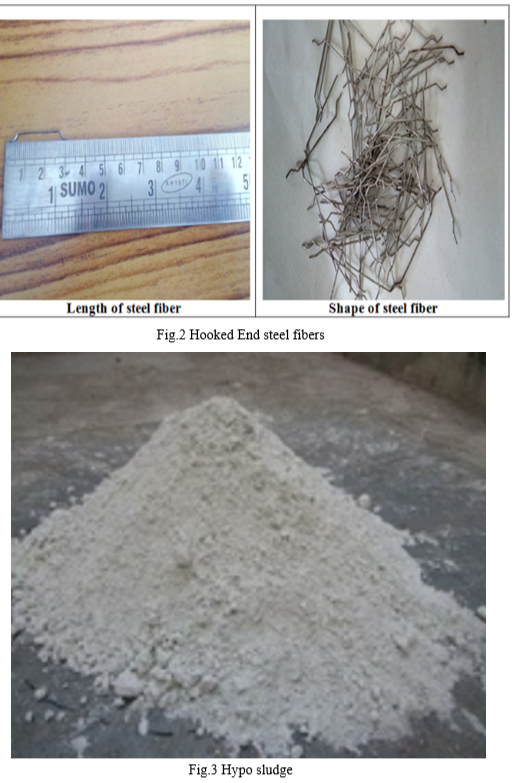
3. Curing and Casting Process: The concrete will then be poured into cube molds, which will be vibrated to ensure correct compaction. The top surface of the cube moulds was finished with a trowel. The cube molds were left to set for 24 hours before the cube specimens were removed from the molds and placed in a water tank to cure.
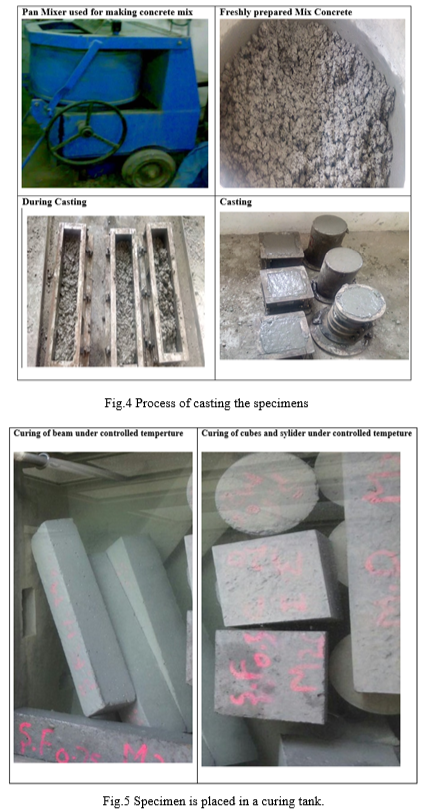
IV. TEST RESULTS AND DISCUSSION
A. Destructive Assessment (Compression Test) & Splitting Tensile Strength Test
The test was carried out on 150mm x 150mm x 150mm cubes. On 7th & 28th day in the curing tank, samples were obtained. Specimens will be placed on a Compression Testing Machine (CTM) with a capacity of 200 tons. Destructive test was carried out in accordance with code Indian standard 516-1979.
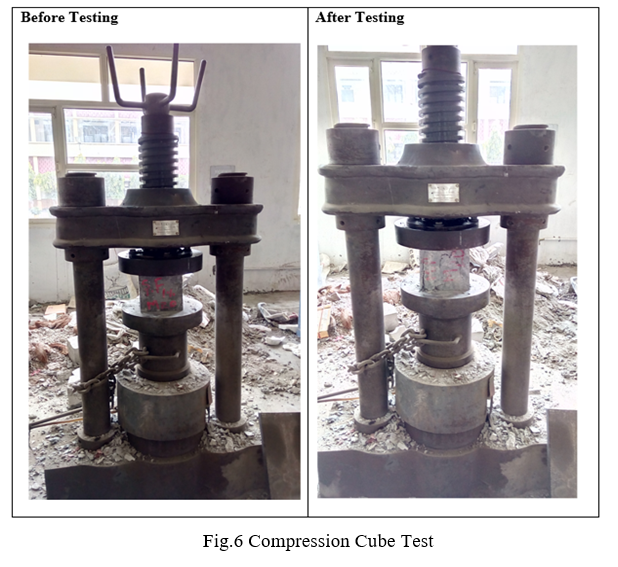
Split tensile strength test was carried out on cylinder specimens with a diameter of 150mm and a length of 300mm. CTM (Compression Testing Machine) used to test cylinder samples (CTM). Load was applied gradually to the cylinders without shock and raised at a consistent rate in N/mm2 until the specimens fail. The test will be performed in accordance with Indian standard 516-1979.
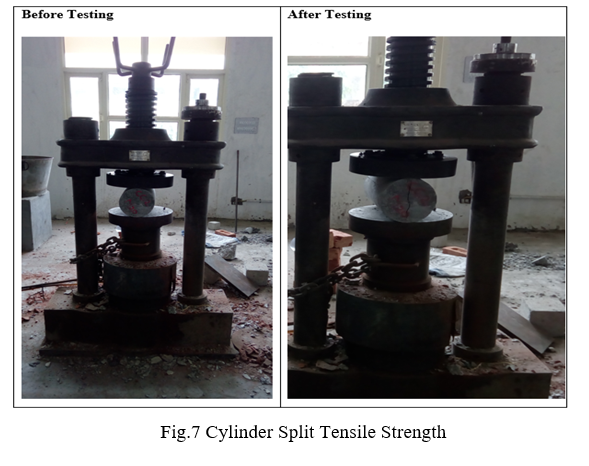
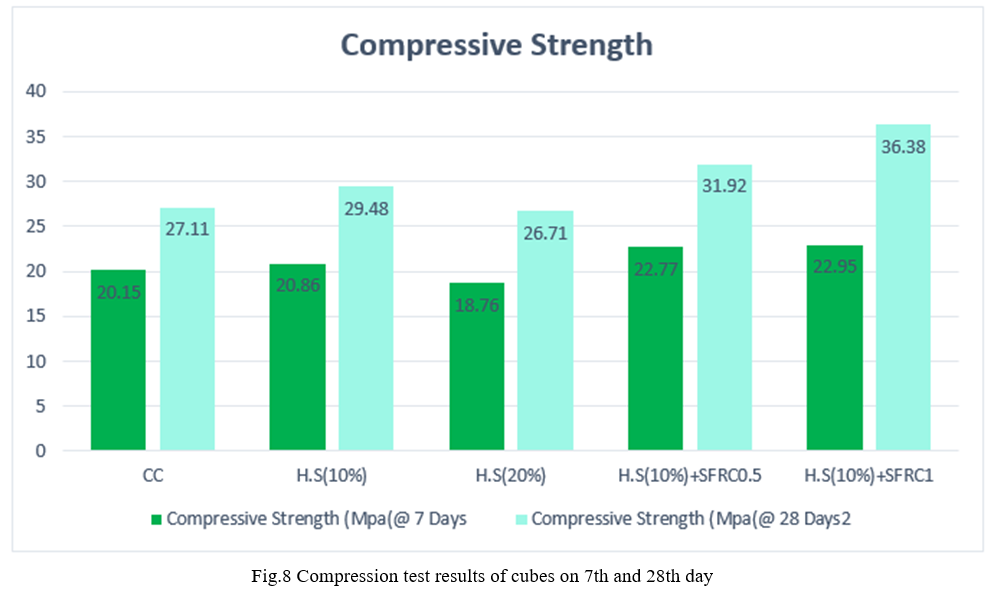
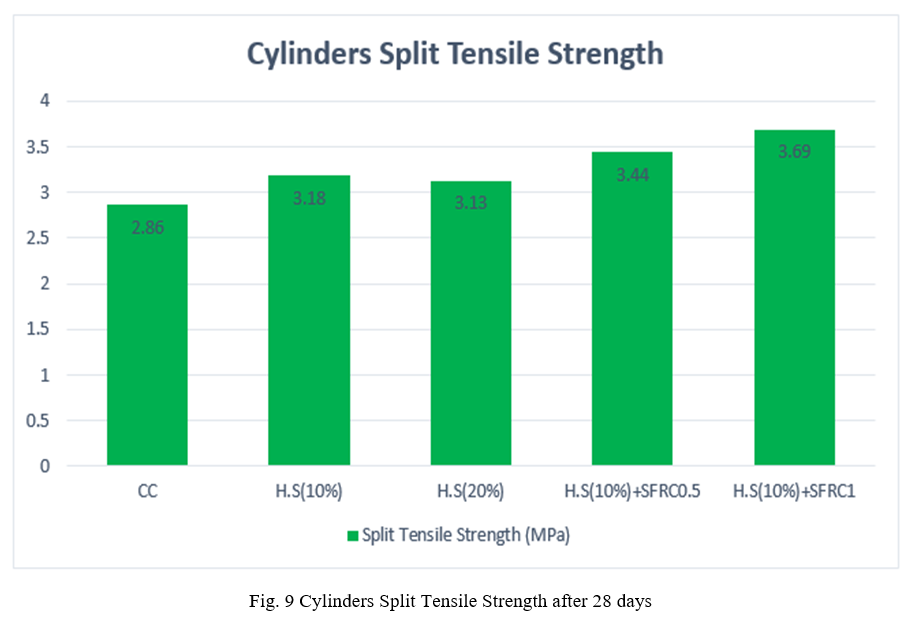
B. Flexural And Water Permeability Test
The tests were carried out on concrete beams with dimensions of 500 mm in length, 100 mm in width, and 100 mm in height. The entire load-deflection curve was recorded for each specimen using the machine's data acquisition system. The test was
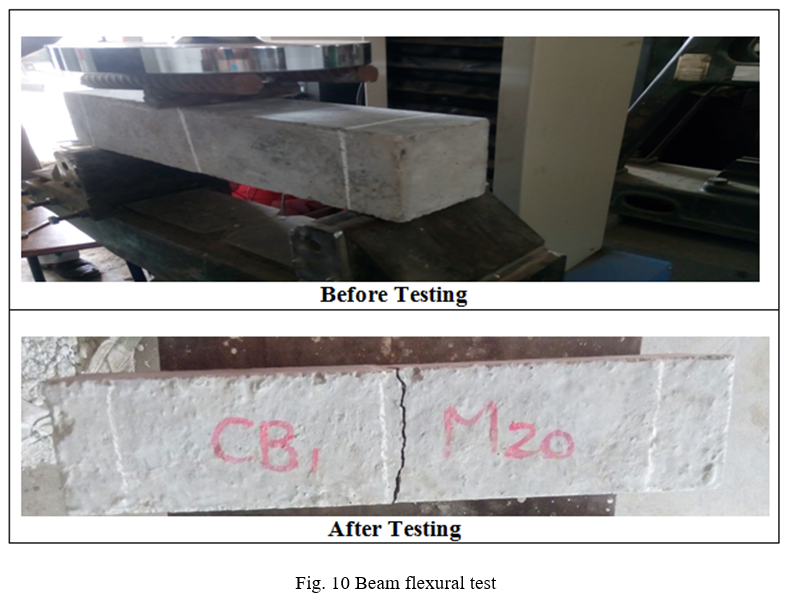
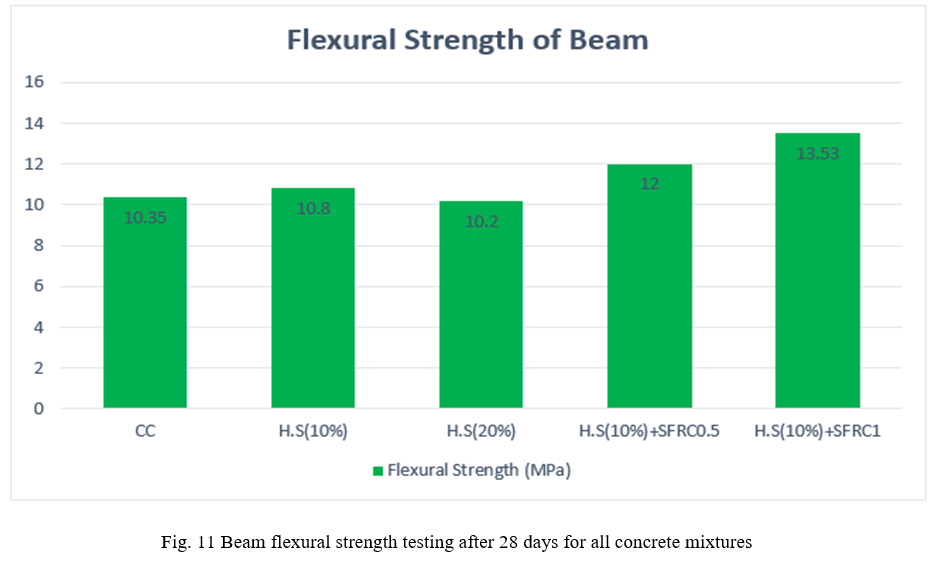
The permeability test will be performed in accordance with Indian standard 3085-1965 norms. To conduct the permeability test, 150mm x 150mm x 150mm cubes were cast and hardened for 28 days. After 28 days of curing, cube specimens were placed in three cell permeability device. The specimen was centered in the container with the bottom end of the specimen resting on the ledge. To a depth of 10mm, jute ropes were employed to fill the angular space between the cube specimen and the cell. The remaining space will be filled with a lac and wax combination that will produce an effective seal. Trials will be the most effective way to determine the right proportion (2:1).
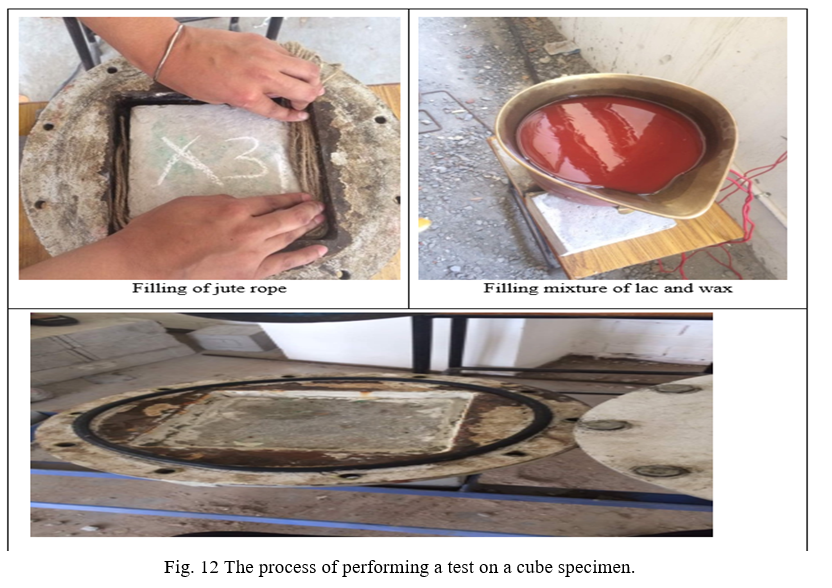
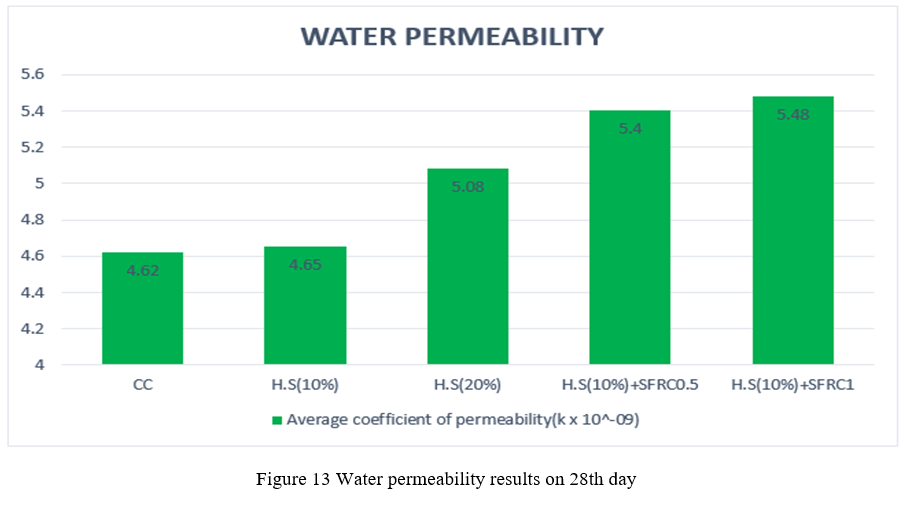
V. ACKNOWLEDGMENT
The constant guidance and encouragement received from my supervisor, Er. Sangitaika Assistant Professor, and co-supervisor Dr. Rajwinder Singh Bansal Professor, RAMGRAHIA INSTITUTE OF ENGINEERING AND TECHONOLGY, has been of great help in carrying out the present work and is acknowledged with respectful thanks. With-out the wise counsel and able guidance, it would have been impossible to complete the thesis in this manner. I also express my deep gratitude to Dr. Rajwinder Singh Bansal (Head of Department of Civil Engineering) RAMGRAHIA INSTITUTE OF ENGINEERING AND TECHONOLGY, a for providing me best laboratory facilities. I express my gratitude to other faculty members of Civil Engineering Department for their knowledgeable support throughout the course of this work. I am thankful to Khanna Mill for providing Hypo sludge and steel fibers providing by my college laboratory. Finally, I am indebted to all whosoever help me in this thesis work and friendly stay with me at Ramgrahia institute of engineering and technology.
Conclusion
Compressive strength on 7th & 28th day, split tensile strength on 28th day, flexural strength on 28th day, and water permeability test on 28th day were all performed according to the procedure outlined in Chapter 3. The following conclusions drawn from the experiment results: 1) As the percentage of hypo sludge replaced via cement in concrete increases, the compressive strength of the concrete decreases slightly, with the compressive strength at 28 days for conventional concrete being 29.48 N/mm2 and 26.71N/mm2 for 20 percent hypo sludge replaced via cement in concrete being 26.71N/mm2. This illustrates that strength may be obtained only when 10% hypo sludge is replaced for cement. 2) Compressive strength increased with the addition of steel fibers (0.5) and hypo sludge (10%), reaching 31.92 after 28 days and 36.38 with steel fibers (1), while the proportion of hypo sludge remained unaltered. 3) The amount of hypo sludge in concrete reduces compressive strength, split tensile strength, and flexural strength. As a result, I was able to maintain a steady percentage of hypo sludge in the steel fibers, which boosted strength. 4) With 20% hypo sludge substitution of cement, the split tensile strength at 28 days is 3.13 N/mm2 and with SFRC0.5+ hypo sludge 20%, the split strength is 3.44N/mm2 at 28 days. 5) Flexural strength falls marginally up to 20% hypo sludge replacement, then increases again in hypo sludge. The flexural strength difference between regular concrete and concrete with 10% hypo sludge is 10.2 MPa. At 28 days, the flexure strength of steel fiber up to 1 fraction and hypo sludge (10 percent) is 13.53. 6) The permeability of OPC and hypo sludge + steel fibers decreases with increase in curing period of samples.
References
[1] Ashish Panday and Tejas Joshi (2017) “Gainful Utilization of hypo sludge in concrete”. International Journal of Civil Engineering and Technology (IJCIET) ISSN Online: 0976-6316. [2] Indian standard: 10260-2009 “Guidelines for concrete mix” Bureau of Indian Standard, New Delhi. [3] Indian standard: 516-1959 “Methods of tests of concrete “Bureau of Indian Standard, New Delhi. [4] Indian standard: 3085 -1965 “Method of test for permeability of cement mortar and concrete” Bureau of Indian Standard, New Delhi [5] Indian standard: 12269 “53 grade ordinary portland cement” Bureau of Indian Standard, New Delhi. [6] Indian standard: 1199-1959(Reaffirmed 2004) “Methods of sampling and analysis of concrete” Bureau of Indian Standard, New Delhi [7] Indian standard: 456-2008 “Code of practice plain and reinforced concrete” Bureau of Indian Standard, New Delhi [8] Indian standard: 2386(Part-1)-1963(Reaffirmed 2004) “Methods of test for aggregate for concrete” Bureau of Indian Standard, New Delhi. [9] Indian standard: 4031 (Part- 4, 5 &6)-1988 “Methods of physical tests for hydraulic cement”, Bureau of Indian Standard, New Delhi. [10] Dharani N, Prince Arulraj G and Goutham J (2015) “Study of mechanical properties of concrete with industrial wastes” Int. Journal of Research in Engineering and Technology, ISSN: 2319-1163. [11] K Hari krishan, N Vidyasagar and Sateesh Konni (2015) “Study of structural performance and durability of concrete by partial replacement of cement with hypo sludge (paper waste)”, Int. Journal of Engineering Research (IJER), Vol-4, Issue-12, pp:635-639. [12] Mingxu Chen, Laibo Li et al (March 2018) “Paper sludge functionalization for achieving fiber- reinforced and low thermal conductivity calcium silicate insulating materials” Journal of Thermal Analysis and Calorimetry. DOI: 10.1007/s10973-018-7682-0 National Natural Science Foundation of China.
Copyright
Copyright © 2022 Jyoti Kaul, Rajwinder Singh Bansal , Arun Verma. This is an open access article distributed under the Creative Commons Attribution License, which permits unrestricted use, distribution, and reproduction in any medium, provided the original work is properly cited.

Download Paper
Paper Id : IJRASET39256
Publish Date : 2021-12-04
ISSN : 2321-9653
Publisher Name : IJRASET
DOI Link : Click Here
 Submit Paper Online
Submit Paper Online

